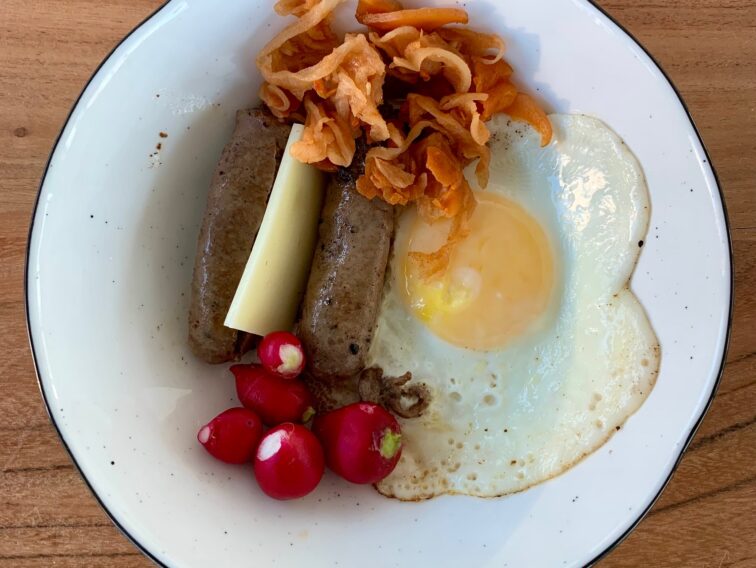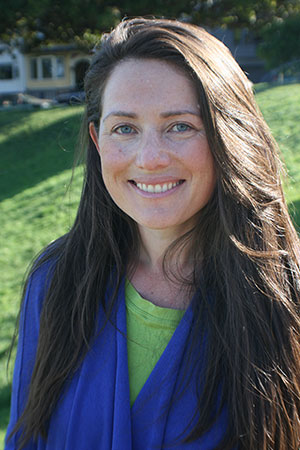The standard American diet is heavy in refined and simple carbs, like toast, pancakes, waffles, oatmeal, cereal, yogurt and granola and fruit-based smoothies.
For most people, these kinds of breakfasts destabilize blood sugar, causing cravings, energy crashes, hunger, poor food choices and mood swings later in the day. A high carb diet raises inflammation, but starting the day with lots of carbs makes it harder to make healthier choices the rest of the day.
You may also feels an energy slump in the late afternoon because of what you ate for breakfast. And feeling this way can make you reach for more carbs or caffeine.
Many of my clients eat protein for lunch or dinner, but starting the day with it is even more important.
What you want to eat a carb-heavy breakfast because it’s what you grew up eating, it’s customary, or because your stomach acid is low (protein will seem unappealing) or there’s microbes (yeast, bacteria or parasites) in your biome that want carbs too.
If stomach acid is an issues (you are not so hungry in the morning), there are ways of supporting stomach acid with a hydrochloric acid supplement or digestive bitters before a meal.
What most of my clients eat
Many of my clients have oatmeal or smoothies for breakfast. Oatmeal has health benefits and is easy to prepare but it could perpetuate leaky gut.
Oatmeal contains lectins, which are harsh, like sandpaper, on the gut lining. You can enjoy oatmeal with a healthy gut lining, but if it’s leaky or inflamed it could be making it worse.
So what you should eat instead?
This is a common question when switching to a gut healing diet. That’s why I’ve included so many breakfast recipes in my Treats That Heal cookbook bundle. I provide many lower carb, anti-inflammatory, biome-building options to replace fruit heavy smoothies and oatmeal.
If starting the day with a protein heavy breakfast does not feel right for you, make sure that you include some protein with your carbs to slow the blood sugar spike.
Animal protein is the easiest source of protein. Things like eggs, sausage, smoked salmon, sardines or tuna. There’s also cottage cheese (if you tolerate dairy), nut butter and tofu. Chia pudding is also a protein, rich plant-based breakfast (recipe in my book).
Some people just choose to eat leftovers from dinner. Super easy.
Protein not only establishes a healthy blood sugar balance for the rest of the day, but also helps repairs and strengthens internal organs.
With stable blood sugar you’re more likely to want healthier foods, have more stable energy so you don’t need a caffeine and sugar fix and be in a better mood so you don’t comfort eat.
Stable blood sugar also lowers the stress response in the body. When blood sugar goes on a rollercoaster, your body produces cortisol, a stress hormone, to bring blood sugar back to balance. Unstable blood sugar stresses the liver and the adrenals.
Constantly pumping cortisol into your system puts you into fight or flight, taking you out of rest and digest mode were you heal. A high sugar diet and severe stress can crash the adrenals.
I’ve had adrenal fatigue and it increases anxiety, zaps your energy, makes you crave sugar. A protein heavy diet is recommended to stabilize this condition.
Everyone is different
Bio individuality was an important concept I was taught in health coaching school. You don’t have to be a health coach to know that different things work for different people. So every recommendation needs to be tailored to your unique body.
When I had IBS, I read about people who healed their IBS with a raw, vegan diet. I tried that diet for many months and it was a complete disaster for me, making me feel much worse. Yet, it healed others. They were not lying, their body was just very different to mine.
I wanted to mention this because it’s important to be balanced with recommendations. If you feel like your oatmeal is working for you, before giving it up, try an experiment.
Eat a different breakfast or several different breakfasts for a week and see if they make you feel better. Write down how you feel mid day and at night after eating a breakfast full of protein or veggies. I have a lovely spaghetti squash porridge in my cookbook bundle.
How do YOU feel when you have eggs or sausage and avocado or spinach, versus oatmeal, versus smoked salmon with tomatoes and cottage cheese, versus a green smoothie, versus a muffin, versus dinner leftovers versus a broth based soup?
If you don’t have time to do this during the week, run the experiment on weekends. See how different breakfasts affects your cravings, fullness, mood, energy and stress for the rest of the day.
My guess is that when you dial in your breakfast to balance blood sugar, it will be easier to eat better all day.
And while we’re taking about breakfast, don’t forget to add protein to the rest of your meals. And while they say breakfast is the most important meal of the day, don’t forget to add protein to your other meals. A big plate of gluten free pasta for lunch or dinner is going to send your blood sugar on the same ride. Especially at night, when your body is more sensitive to carbs.
Adding a can of tuna to your pasta, with some wilted spinach and olives can add protein, fiber and fat to your plate to slow down your sugar spike.
Don’t forget to add protein powder to your smoothies and blend meat/protein into your soups.
And if you’re sensitive to eggs, here are some ideas for egg free breakfasts.
And lastly, you can use a continuous glucose monitor if you want to measure your blood sugar in real time to keep it more stable and figure out what foods set it off. They are expensive, but can provide valuable feedback in just 2 weeks. It could be a worthwhile investment to help personalize your diet. I know that managing my blood sugar was an important part of my recovery.
Nutrisense in the U.S. and Supersapiens in Europe are just two of the companies that sell blood sugar monitors to consumers.
Hope that some of these resource and information can help you start your day off right so you can feel better each day and reach your healing goals.


